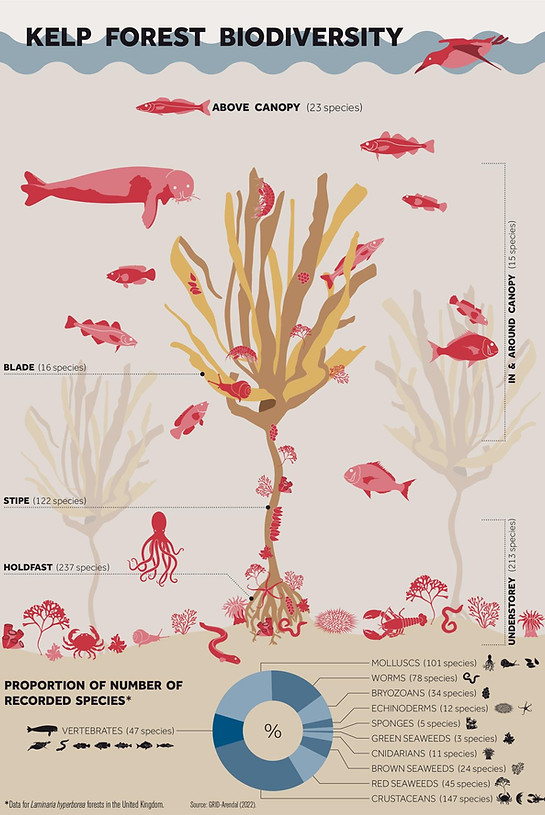
KELP FORESTS ARE MARINE ECOSYSTEMS THAT PROVIDE HABITAT FOR A DIVERSE RANGE OF MARINE SPECIES AND PLAY A CRUCIAL ROLE IN MAINTAINING OCEANIC BIODIVERSITY.
Kelp forests are underwater ecosystems dominated by large, brown seaweeds known as kelp, which typically thrive in cold, nutrient-rich waters with temperatures ranging from 50 to 60 degrees Fahrenheit (10 to 15 degrees Celsius). They live in various parts of the world, including the coastlines of California, Alaska, Chile, Australia, and South Africa.
There are two prominent players in these thriving habitats: Macrocystis pyrifera, known as giant kelp, and Nereocystis luetkeana, commonly referred to as bull kelp.
Macrocystis pyrifera is the dominant species in kelp forests. It is an incredibly fast-growing alga, capable of growing up to two feet (60 centimetres) per day and reaching heights of up to 200 feet (60 meters). To grow vertically so high towards the surface, they anchor themselves to the seabed using a prehensile peduncle (holdfast) and use gas-filled vesicles, which promote the flotation of the stem and the numerous, characteristically sword-shaped leaves.
.jpg)
Bull kelp (Nereocystis luetkeana) is generally shorter than giant kelp and reaches lengths of up to 60 feet (18 meters). Its common name is derived from the prominent, bulbous, gas-filled float referred to as the 'bull's head,' situated at the apex of its long, slender stalk. This float enables bull kelp to stay afloat and near the water's surface, even in turbulent coastal waters.
KELP FORESTS, WITH THEIR INTRICATE UNDERWATER JUNGLES OF TOWERING SEAWEED, SUPPORT A RICH TAPESTRY OF BIODIVERSITY.
The towering kelp plants create a three-dimensional habitat that offers shelter, food, and breeding grounds for a diverse range of marine organisms. The roots and the floating foliage of the kelp create a complex structure that provides protection and hiding places for small fish, invertebrates, and microscopic organisms. It serves as a nursery for juvenile fish, protecting them from predators.
Fish such as rockfish, lingcod, and leopard sharks navigate through the forest, seeking refuge and hunting smaller prey.

Kelp forest biodiversity
Illustration from Into the Blue by the United Nations Environment Programme
The kelp forests also support an array of invertebrates, including sea stars, anemones, crabs, snails, and sea cucumbers. These organisms utilize the kelp's holdfasts (root-like structures) and blades as attachment points, feeding grounds, and protective cover.
Additionally, kelp forests attract migratory species such as sea turtles and various marine birds, which rely on the abundant food sources found in these ecosystems.

.jpg)
California sheephead (Semicossyphus pulcher) is a fish species found in the eastern Pacific Ocean.
It exhibits sequential hermaphroditism, transitioning from female to male. Females develop eggs, but as they grow older, some undergo sex reversal to become males. Males establish territories, court females, and guard their eggs until they hatch.
.jpg)


.jpg)
URCHIN BARRENS POSE A SIGNIFICANT THREAT TO KELP FORESTS.
When sea urchin populations proliferate, they can ravage kelp to the point of depletion, leading to the formation of 'urchin barrens'—areas where the ecosystem faces catastrophic consequences.
This problem is exacerbated by factors such as reduced natural predators, the influence of climate change that favors urchins over kelp, nutrient runoff causing excessive algal growth, and human activities that damage marine habitats.

This is where the vital roles of sea otters and sea stars become evident.
Sea otters serve as natural predators of sea urchins and regularly feed on them. Their presence and hunting activities play a crucial role in controlling sea urchin populations, preventing overgrazing that could harm kelp forests. Sea stars also contribute to this delicate balance by preying on sea urchins, thus helping to maintain the overall equilibrium of the ecosystem.
The intricate interplay among algae, sea urchins, sea otters, and other marine species represents a delicate balance within kelp forests. Therefore, the conservation and protection of kelp forest habitats are of utmost importance to preserve marine biodiversity and ensure the stability of ocean ecosystems.
.jpg)
.jpg)
KELP FORESTS ARE HIGHLY EFFICIENT AT SEQUESTERING CARBON AND STORING IT, HELPING TO REDUCE GREENHOUSE GAS CONCENTRATIONS AND COMBAT CLIMATE CHANGE.
Kelp forests are called 'blue carbon' ecosystems because they can sequester significant amounts of carbon in their tissues, acting as valuable carbon sinks. Like other photosynthetic organisms, kelp uses sunlight and CO2 to produce biomass and release oxygen through photosynthesis. Its rapid growth allows it to rapidly accumulate biomass and efficiently capture and store carbon, playing a crucial role in mitigating climate change.
